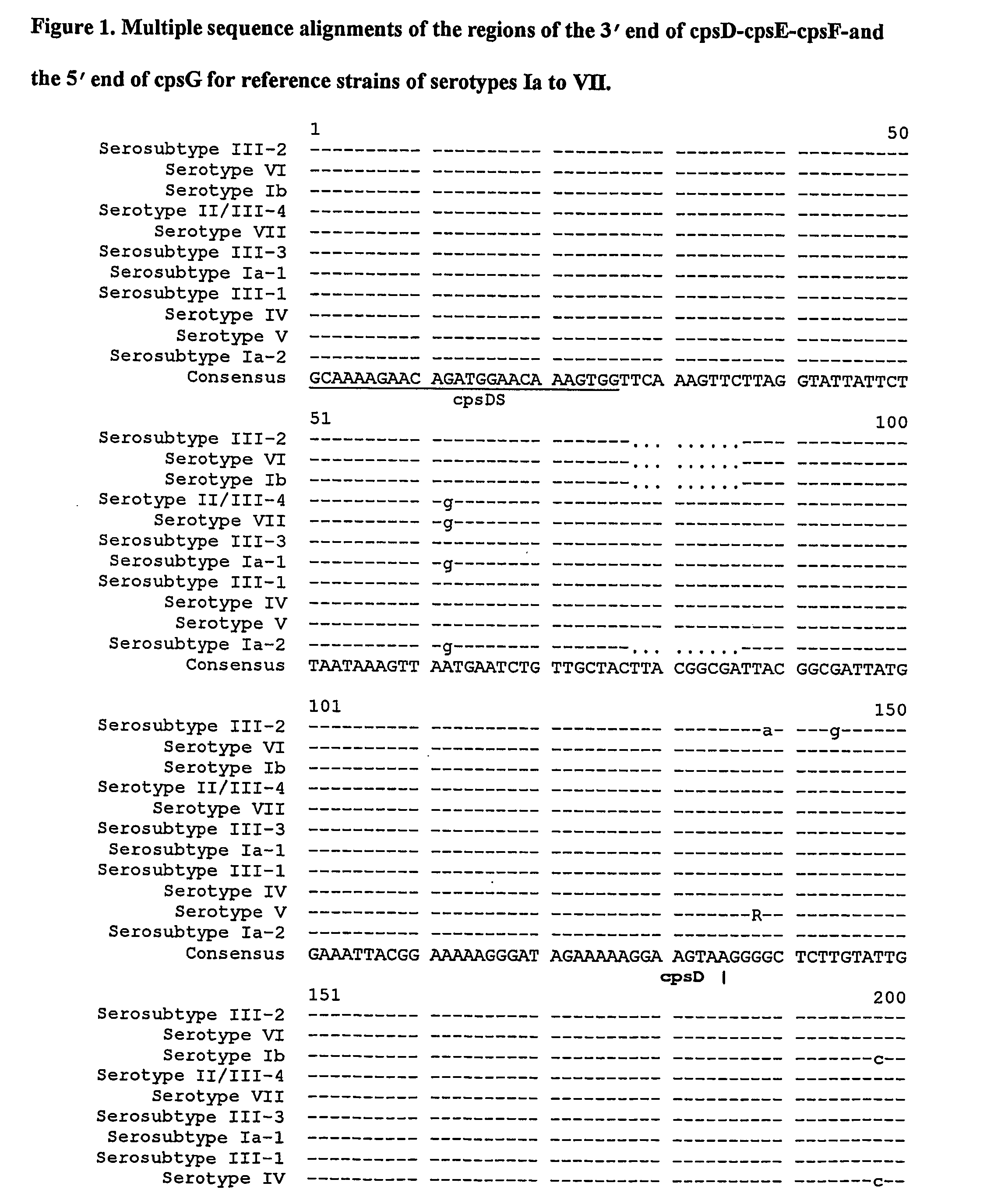Molecular typing of group B streptococci
a group b streptococci and molecular typing technology, applied in the field of molecular typing of group b streptococci, can solve the problems of high-titered serotype-specific antisera, high-titered serotype-specific antisera, and reduced neonatal gbs sepsis inciden
- Summary
- Abstract
- Description
- Claims
- Application Information
AI Technical Summary
Problems solved by technology
Method used
Image
Examples
example 1
Study of inter- and intra-serotype / serosubtype Sequence Heterogeneity in Specific Regions of the GBS Genome and Assessment of Suitability for Molecular Serotyping / Serosubtyping
[0132] Polymerase Chain Reaction.
[0133] With two exceptions, all GBS-specific primer pairs produced amplicons of the expected size from all reference strains and clinical Isolates tested (Table 3). The exceptions were Sag59 / Sag190 and CFBS / CFBA Both target the cfb gene, but failed to produce amplicons from one clinical Isolate, despite repeated attempts. We assumed that this isolate either lacked the cfb gene or that the gene was present in a mutant form. It has been suggested previously that PCR targeting the cfb gene will not identify all GBS isolates (Hassan et al., 2000) and that another primer pair based on 16S rRNA gene, DSF2 / DSR1 (Ahmet et al., 1999) was not entirely specific. Therefore, in this study, we used both primer pairs (DSF2 / DSR1 and Sag59 / Sag190) to confirm all the isolates were GBS.
[0134] Seq...
example 2
Molecular Serotype Identification (MS) Based on MS-Specific PCR Targeting the 3'-end of cpsG-cpsH-cps I / cpsM
[0151] Our sequence alignment results showed that there was significant sequence heterogeneity in the 3'-end of cpsG-cpsH-cps I / cpsM (FIG. 3), which makes it appropriate for use in the design of specific primer pairs for differentiation of serotypes Ia, Ib, III, IV, V, and VI directly by PCR. To fulfil possible additional future requirements--for example, development of multiplex PCR and / or to allow further evaluation of the sequence typing method, we designed several primer pairs for each serotype (Tables 2 & 3). Using two panels of reference strains and the specified conditions, all primer pairs amplified DNA only from the corresponding serotypes. When clinical isolates were tested, similar results were obtained with two sets of MS-specific primer pairs. In general, more stringent conditions (lower primer concentration, higher annealing temperatures) could be used with prime...
example 3
Comparison of Serotype Identification Results between MS and CS
[0153] After CS and MS had been completed, the results were compared. Initial results were discrepant for 15 isolates, all but five of which (see below) were resolved by retesting and / or correction of clerical errors.
[0154] The CS and MS / sequence subtyping results are shown in Table 5. A MS was assigned to all isolates by PCR and / or sequencing, compared with 188 of 206 (91.3%) by CS. Specific PCR has not yet been developed for MS II and VIII, so all MS II isolates were determined by sequencing only and one presumptive MS VIII isolate was decided by exclusion (see Example 1). For all other isolates, the results of PCR and sequencing were consistent, except for serosubtypes III-3 and III-4 and other minor sequence differences described above (Example 1). CS results correlated well with PCR results.
[0155] Final CS and MS results were the same for all 188 isolates (100%) for which results for both methods were available. Eig...
PUM
| Property | Measurement | Unit |
|---|---|---|
| melting temperature | aaaaa | aaaaa |
| melting temperatures | aaaaa | aaaaa |
| pH | aaaaa | aaaaa |
Abstract
Description
Claims
Application Information
 Login to View More
Login to View More - R&D
- Intellectual Property
- Life Sciences
- Materials
- Tech Scout
- Unparalleled Data Quality
- Higher Quality Content
- 60% Fewer Hallucinations
Browse by: Latest US Patents, China's latest patents, Technical Efficacy Thesaurus, Application Domain, Technology Topic, Popular Technical Reports.
© 2025 PatSnap. All rights reserved.Legal|Privacy policy|Modern Slavery Act Transparency Statement|Sitemap|About US| Contact US: help@patsnap.com



